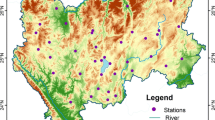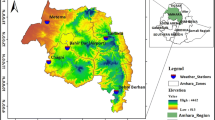Abstract
Since the 1990s, many meteorological stations in China have passively “entered” cities, which has led to frequent relocation and discontinuity in observational records at many stations. To study the impacts of urbanization on surface air temperature series, 52 meteorological stations in Anhui Province were chosen based firstly on a homogeneity test of the time series, and then their surrounding underlying surfaces during different decades were identified utilizing Landsat Multispectral Scanner images from the 1970s, Landsat Thematic Mapper images from 1980s and 1990s, and Enhanced Thematic Mapper images after 2000, to determine whether or not the station “entered” city, and then these stations were categorized into three groups: urban, suburban, and rural using Landsat-measured land use/land cover (LULC) around the station. Finally, variations in annual mean air temperature (T mean), maximum air temperature (T max), and minimum air temperature (T min) were analyzed in urban-type stations and compared to their surrounding rural-type stations. The results showed that, in Anhui Province over the past two decades, many rural stations experienced urbanization and changed into urban or suburban locations. This process is referred as the “city-entering” phenomena of stations. Consequently, many of the latest stations were relocated and moved to currently rural and suburban areas, which significantly influenced the continuity of observational records and the homogeneity of long-term trends. Based on homogeneous data series, the averaged annual T mean, T max, and T min over Anhui Province increased at a rate of 0.407, 0.383 and 0.432 °C decade−1 from 1970 to 2008. The strongest effect of urbanization on annual T mean, T max, and T min trends occurred at urban stations, with corresponding contributions of 35.824, 14.286, and 45.161 % to total warming, respectively. This work provides convincing evidences that (1) urban expansion has important impacts on the evaluation of regional climate change, (2) high spatial resolution images of Landsat are very useful for selecting reference climate stations for evaluating the potential urban bias in the surface air temperature data in certain regions of the continents, and (3) meteorological observation adjustments of station-relocation-induced inhomogeneities are essential for the study of regional or global climate change.










Similar content being viewed by others
References
Easterling, D.R., Horton B., Jones, P.D., Peterson, T. C., Karl, T.R., Parker, D. E., Salinger, M.J., Razuvayev, V., Plummer, N., Jamason, P. and Folland, C.K. (1997). Maximum and minimum temperature trends for the globe. Science, 277, pp. 364–367.
Gallo, K. P., Easterling, D. R. and Peterson, T.C. (1996a). The influence of land use/land cover on climatological values of the diurnal temperature range. Journal of Climate, 9(11), pp. 2941–2944.
Gallo, K.P., Tarpley, J.D. (1996b). The comparison of vegetation index and surface temperature composites for urban heat island analysis. International Journal of Remote Sensing, 17, pp. 3071–3076.
Gallo, K. P., Owen, T. W., Easterling, D. R. and Jamason, P. F. (1999). Temperature trends of the US historical climatology network based on satellite-designated land use/land cover. Journal of Climate, 12, pp. 1344–1348.
Gao X.J., Luo Y., Lin W.T., Zhao Z.C and Giorgi P. (2003). Simulation of effects of land use change on climate in China by a regional climate model. Advances in Atmospheric Science, 20, pp. 583–592.
Gao Z. Q., J. C. Ning, and W. Gao, (2009). Response of land surface temperature to coastal land use/cover change by remote sensing, Transactions of the CSAE, 25(9): 274–181.
Hansen, J. E., Ruedy,R., Sato, M., Imhoff, M., Lawrence, W., Easterling, D., Peterson,T., and Karl, T. (2001). A closer look at United States and global surface temperature change. Journal of Geophysical Research, 106, pp. 23947–23963.
He, J. F., Liu, J. Y., Zhuang, D. F., Zhang, W. and Liu, M. L. (2007). Assessing the effect of land use/land cover change on the change of urban heat island intensity. Theoretical and Applied Climatology, 90, pp. 217–226. doi:10.1007/s00704-006-0273-1.
Hua L. J., Z. G. Ma, W. D. Guo (2008), The impact of urbanization on air temperature across China. Theoretical and Applied Climatology 93:179–194. doi:10.1007/s00704-007-0339-8.
Hu, Y., W. Dong, and Y. He (2010), Impact of land surface forcings on mean and extreme temperature in eastern China, Journal of Geophysical Research, 115, D19117, doi:10.1029/2009JD013368.
Li, Q., Zhang, H., Liu, X. and Huang, J. (2004). Urban heat island effect on annual mean temperature during the last 50 years in China. Theoretical and Applied Climatology, 79(3–4), pp. 165–174.
Li, Q., W. Li, P. Si, X. Gao, W. Dong, P. Jones, J. Huang, and L. Cao (2010), Assessment of surface air warming in northeast China, with emphasis on the impacts of urbanization, Theoretical and Applied Climatology, 99(3–4), 469–478. doi:10.1007/s00704-009-0155-4.
Li Z and Yan Z (2010). Application of Multiple Analysis of Series for Homogenization (MASH) to Beijing daily temperature series 1960–2006. Advances in Atmospheric Sciences. 27(4)777–787. doi:10.1007/s00376-009-9052-0.
Li Z.H., J. Yang, C.E. Shi and M.J. Pu. (2011).Urbanization Effects on Fog in China: Field Research and Modeling, Pure and Applied Geophysics, doi:10.1007/s00024-011-0356-5.
Liu, W., Ji C., Zhong, J., Jiang, X. and Zheng, Z.(2007). Temporal characteristics of the Beijing urban heat island. Theoretical and Applied Climatology, 87(1–4), pp.213-221, doi:10.1007/s00704-005-0192-6.
Jones, P. D., P. Y. Groisman, M.C oughlan, N. Plulmmer, W. C. Wang, and T. R. Karl, (1990). Assessment of urbanization effects in time series of surface air temperature over land. Nature, 347:169–172.
Jones, P.D., Lister, D.H. and Li, Q., (2008). Urbanization effects in large-scale temperature records, with an emphasis on China. Journal of Geophysical Research, 113, D16122, doi:10.1029/2008/JD009916.
Kalnay, E. and Cai, M. (2003). Impact of urbanization and land-use change on climate. Nature, 423, pp. 528–531.
Kalnay, E., Cai, M., Li, H., and Tobin J. (2006). Estimation of the impact of land-surface forcings on temperature trends in eastern United States. Journal of Geophysical Research, 111(D06106), pp. 1–13.
Oke, T.R. (1973). City size and the urban heat island. Atmospheric Environment, 7, pp. 769–779.
Oke, T.R. (1982). The energetic basis of the urban heat island. Quarterly Journal of the Royal Meteorological Society, 108, pp. 1–24.
Owen, T.W., Carlson, T.N., and Gillies, R.R. (1998). An assessment of satellite remotely-sensed land cover parameters in quantitatively describing the climatic effect of urbanization. International Journal of Remote Sensing, 19, pp. 1663–1681.
Parker, D. E. (2004a). Large-scale warming is not urban. Nature, 432, pp. 290–290.
Parker, D. E. (2004b). A Demonstration That Large-Scale Warming Is Not Urban. Journal of Climate, 19, pp. 2882–2895.
Peterson, T.C. (2003). Assessment of Urban Versus Rural In Situ Surface Temperatures in the Contiguous United States: No Difference Found. Journal of Climate, 16(18), pp. 2941–2959.
Pielke, Sr R. A., Marland, G., Betts, R. A., Chase, T. N., Eastman, J.L., Niles, J.O., Niyogi, D. and Running, S. W. (2002). The influence of land-use change and landscape dynamics on the climate system: Relevance to climate-change policy beyond the radiative effects of greenhouse gases. Philosophical Transactions of. The Royal Society A, 360, pp. 1–15.
Ren, G. Y., Z. Y. Chu, Z. H. Chen, and Y. Y. Ren, 2007: Implications of temporalchange in urban heat island intensity observed at Beijing and Wuhan stations. Geophys. Res. Lett., 34, L05711.
Ren, G.Y., Zhou, Y.Q, Chu, Z.Y., Zhou, J.X., Zhang, A.Y., Guo, J. and Liu, X.F. (2008). Urbanization effects on observed surface air temperature trends in North China. Journal of Climate, 21, pp. 1333–1348.
Ren G.Y., Zhang, A.Y., Chu, Z.Y., Zhou, J.X., Ren Y.Y, Zhou, Y.Q (2010). Principles and procedure for selecting reference surface air temperature stations in China. Meteorological Science and Technology, 38(1):78–85. (in Chinese).
Ren Y.Y, Ren G.Y., (2011). A Remote-Sensing Method of Selecting Reference Stations for Evaluating Urbanization Effect on Surface Air Temperature Trends. Journal of Climate, 24, 3179–3189.
Roth, M., Oke, T.R., and Emery, W.J. (1989). Satellite-derived urban heat islands from three coastal cities and the utilization of such data in urban climatology. International Journal of Remote Sensing, 10, pp. 1699–1720.
Shi C, Roth M, Zhang H, and Li Z.H. (2008). Impacts of urbanization on long-term variation of fog in Anhui Province, China, Atmospheric Environment, 42:8484–8492.
Wijngaard JB, Klein AMG, Konnen GP (2003) Homogeneity of 20th century European daily temperature and precipitation series. International Journal of Climatology. 23:679–692.
Weng, Q., 2001, A remote sensing-GIS evaluation of urban expansion and its impact on surface temperature in the Zhujiang Delta, China. International Journal of Remote Sensing, 22(10), pp. 1999–2014.
Yan Z, Li Z, Li Q, Jones PD, (2010). Effects of site-change and urbanisation in the Beijing temperature series 1977–2006. International Journal of Climatology. 30(8)1226–1234. doi:10.1002/joc.1971.
Yang, L. (2000). Integration of a numerical model and remotely sensed data to study urban/rural land surface climate processes. Computers & Geosciences, 26:451-468.
Yang, X., Y. Hou, and B. Chen (2011a), Observed surface warming induced by urbanization in east China, Journal of Geophysical Research, 116, D14113, doi:10.1029/2010JD015452.
Yang Y.J., Shi T., Tang W.A., Wu B.W., Xun S.P., Zhang H.Q., (2011b). Study of Observational Environment of Meteorological Station Based on Remote Sensing:Cases in six stations of Anhui province. Remote Sensing Technology and Application, 2011, 26(6):791–797. (in Chinese).
Zhang, A.Y., G.Y. Ren, J.X. Zhou, et al., (2010). On the urbanization effect on surface air temperature trends over China, Acta Meteorological Sinica, 68(6):957–966 (in Chinese).
Zhang, K.X., Wang, R., Shen, C.C., and Da, L.J. (2010). Temporal and spatial characteristics of the urban heat island during rapid urbanization in Shanghai, China. Environmental Monitoring and Assessment, 169, pp. 101–112.
Zhang, J.H., Hou, Y.Y., Li, G. C., Yan, H., Yang, L.M, and Yao, F.M. (2005). The diurnal and seasonal characteristics of urban heat island variation in Beijing City and surrounding areas and impact factors based on remote sensing satellite data, Sciences in China ser. D Earth Sciences, 48, pp. 220–229.
Zhou, L.M., Robert, E. D., Tian, Y. H., Fang, J.Y., Li, Q.X, Kaufmann, R.B, Tucker, C.J. and Myneni, R.B. (2004). Evidence for a significant urbanization effect on climate in China. Proceedings of the National Academy of Sciences of the United States of America, 101(26), pp. 9540–954.
Zhou, Y.Q. and Ren, G.Y., (2011). Change in extreme temperature events frequency over mainland China during 1961–2008, Climate Research, 50(1–2):125–139. doi:10.3354/cr01053.
Acknowledgments
We thank the anonymous reviewers for their useful comments and suggestions. This study was supported by the National Natural Science Foundation of China (No. 41205126) and Open Research Fund of Key Laboratory of Atmospheric Composition and Optical Radiation of Chinese Academy of Sciences (Grant.JJ1102), Global Change Global Research key Project of National Science Plan (Grant. 2010CB951302), ‘100 Talents Project’ of Chinese Academy of Sciences, Open Research Fund of State Key of Laboratory of Atmospheric Boundary Physics and Atmospheric Chemistry (LAPC-KF-2011-05), Meteorological Research Fund of Anhui Meteorological Bureau (KM201208) and the National Program on Key Basic Research Project of China (2010CB428502).
Author information
Authors and Affiliations
Corresponding author
Rights and permissions
About this article
Cite this article
Yang, YJ., Wu, BW., Shi, Ce. et al. Impacts of Urbanization and Station-relocation on Surface Air Temperature Series in Anhui Province, China. Pure Appl. Geophys. 170, 1969–1983 (2013). https://doi.org/10.1007/s00024-012-0619-9
Received:
Revised:
Accepted:
Published:
Issue Date:
DOI: https://doi.org/10.1007/s00024-012-0619-9




